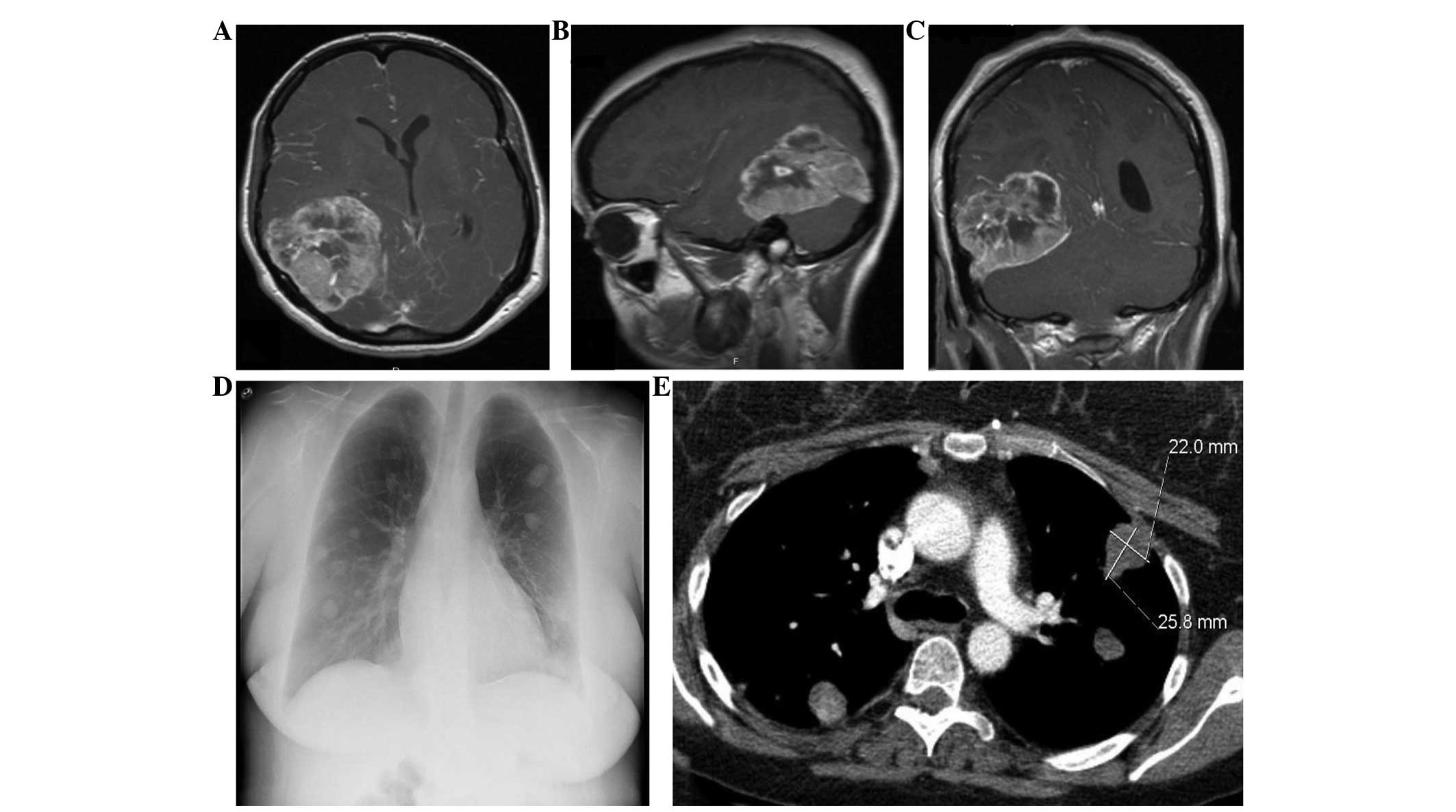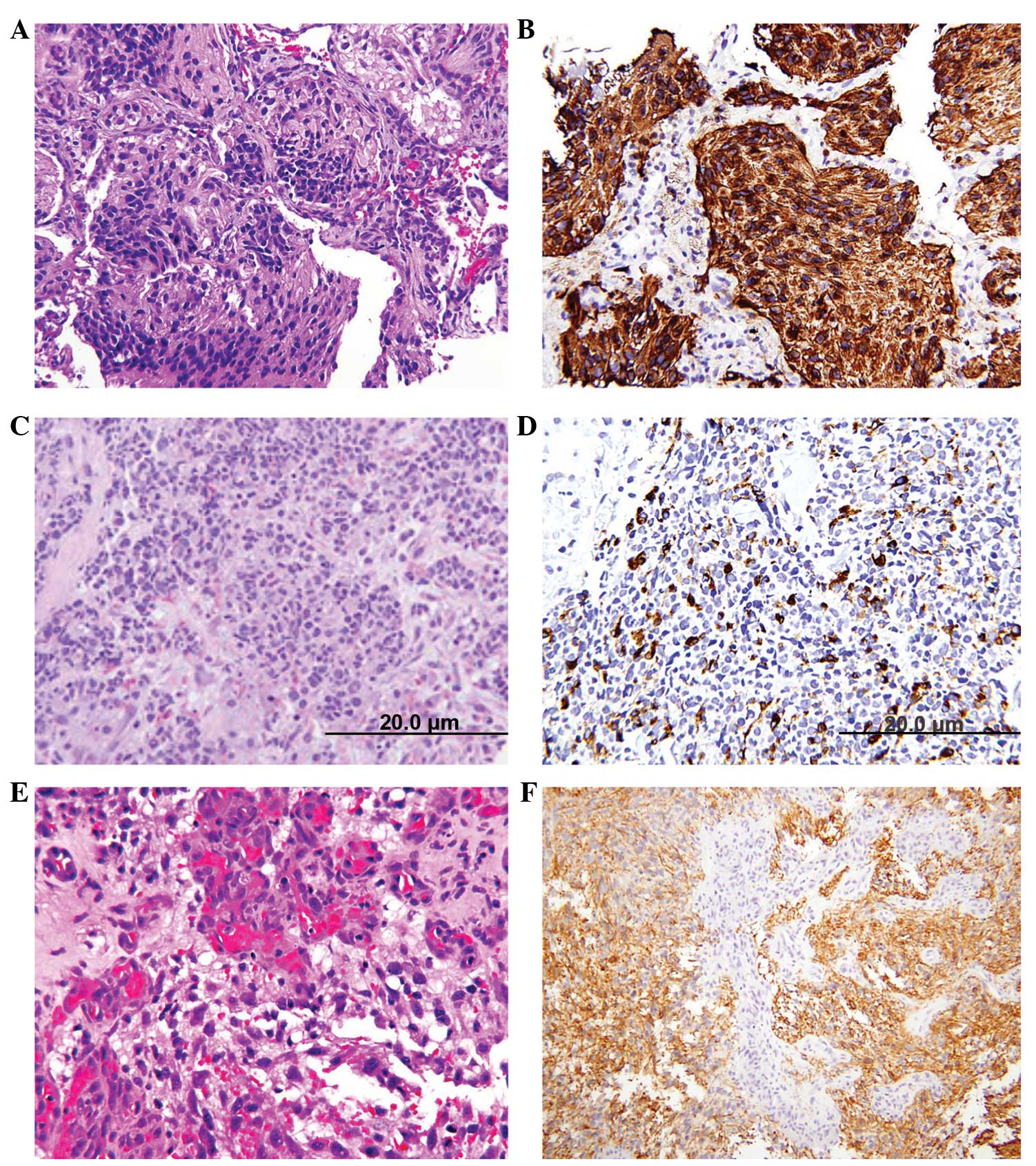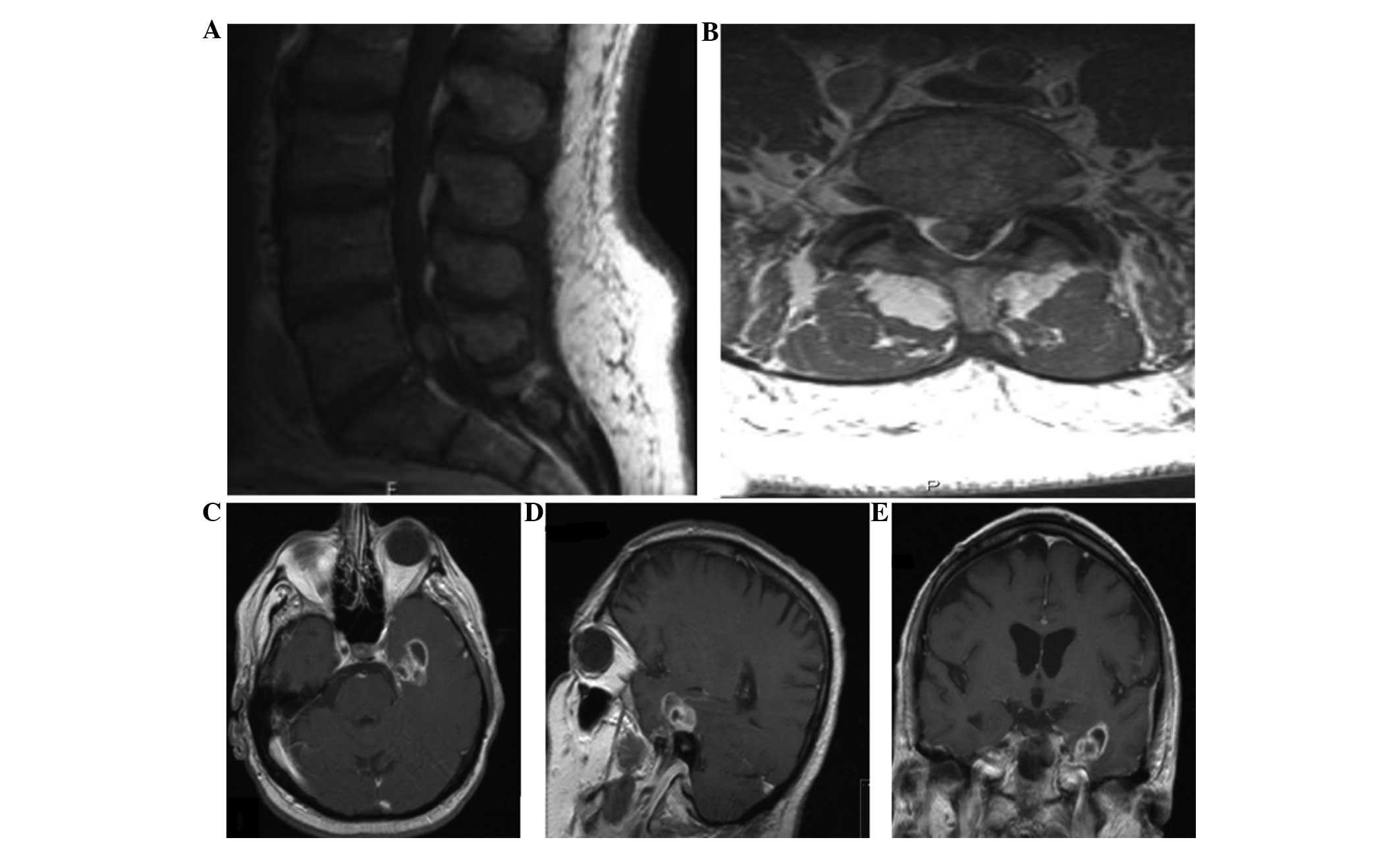|
1
|
Saad AG, Sachs J, Turner CD, et al:
Extracranial metastases of glioblastoma in a child: case report and
review of the literature. J Pediatr Hematol Oncol. 29:190–194.
2007. View Article : Google Scholar : PubMed/NCBI
|
|
2
|
Rajagopalan V, El Kamar FG, Thayaparan R
and Grossbard ML: Bone marrow metastases from glioblastoma
multiforme – a case report and review of the literature. J
Neurooncol. 72:157–161. 2005. View Article : Google Scholar : PubMed/NCBI
|
|
3
|
Datta CK, Weinstein JD, Bland JE, Brager
PM and Stewart MA: A case of cervical lymph node metastasis
resulting from glioblastoma multiforme. W V Med J. 94:276–278.
1998.PubMed/NCBI
|
|
4
|
Fecteau AH, Penn I and Hanto DW:
Peritoneal metastasis of intracranial glioblastoma via a
ventriculoperitoneal shunt preventing organ retrieval: case report
and review of the literature. Clin Transplant. 12:348–350.
1998.PubMed/NCBI
|
|
5
|
Piccirilli M, Brunetto GM, Rocchi G,
Giangaspero F and Salvati M: Extra central nervous system
metastases from cerebral glioblastoma multiforme in elderly
patients. Clinico-pathological remarks on our series of seven cases
and critical review of the literature. Tumori. 94:40–51.
2008.PubMed/NCBI
|
|
6
|
Templeton A, Hofer S, Töpfer M, et al:
Extraneural spread of glioblastoma – report of two cases.
Onkologie. 31:192–194. 2008. View Article : Google Scholar : PubMed/NCBI
|
|
7
|
Widjaja A, Mix H, Gölkel C, et al:
Uncommon metastasis of a glioblastoma multiforme in liver and
spleen. Digestion. 61:219–222. 2000. View Article : Google Scholar : PubMed/NCBI
|
|
8
|
Yasuhara T, Tamiya T, Meguro T, et al:
Glioblastoma with metastasis to spleen – case report. Neurol Med
Chir (Tokyo). 43:452–456. 2003. View Article : Google Scholar : PubMed/NCBI
|
|
9
|
Lun M, Lok E, Gautam S, Wu E and Wong ET:
The natural history of extracranial metastasis from glioblastoma
multiforme. J Neurooncol. 105:261–273. 2011. View Article : Google Scholar : PubMed/NCBI
|
|
10
|
Armanios MY, Grossman SA, Yang SC, White
B, Perry A, Burger PC and Orens JB: Transmission of glioblastoma
multiforme following bilateral lung transplantation from an
affected donor: case study and review of the literature. Neuro
Oncol. 6:259–263. 2004. View Article : Google Scholar : PubMed/NCBI
|
|
11
|
Chen H, Shah AS, Girgis RE and Grossman
SA: Transmission of glioblastoma multiforme after bilateral lung
transplantation. J Clin Oncol. 26:3284–3285. 2008. View Article : Google Scholar : PubMed/NCBI
|
|
12
|
Mentrikoski M, Johnson MD, Korones DN and
Scott GA: Glioblastoma multiforme in skin: a report of 2 cases and
review of the literature. Am J Dermatopathol. 30:381–384. 2008.
View Article : Google Scholar : PubMed/NCBI
|
|
13
|
Bouillot-Eimer S, Loiseau H and Vital A:
Subcutaneous tumoral seeding from a glioblastoma following
stereotactic biopsy: case report and review of the literature. Clin
Neuropathol. 24:247–251. 2005.PubMed/NCBI
|
|
14
|
Sloan AE, Ahluwalia MS, Valerio-Pascua J,
et al: Results of the NeuroBlate System first-in-humans phase I
clinical trial for recurrent glioblastoma: clinical article. J
Neurosurg. 118:1202–1219. 2013. View Article : Google Scholar : PubMed/NCBI
|
|
15
|
Armstrong TS, Prabhu S, Aldape K, et al: A
case of soft tissue metastasis from glioblastoma and review of the
literature. J Neurooncol. 103:167–172. 2011. View Article : Google Scholar : PubMed/NCBI
|
|
16
|
Lin ZX, Yang LJ, Huang Q and Fu J:
Activated vascular endothelia regulate invasion of glioma cells
through expression of fibronectin. Chin Med J (Engl).
123:1754–1761. 2010.PubMed/NCBI
|
|
17
|
Mourad PD, Farrell L, Stamps LD, Chicoine
MR and Silbergeld DL: Why are systemic glioblastoma metastases
rare? Systemic and cerebral growth of mouse glioblastoma. Surg
Neurol. 63:511–519. 2005. View Article : Google Scholar : PubMed/NCBI
|
|
18
|
Park CC, Hartmann C, Folkerth R, et al:
Systemic metastasis in glioblastoma may represent the emergence of
neoplastic subclones. J Neuropathol Exp Neurol. 59:1044–1050.
2000.PubMed/NCBI
|
|
19
|
Beaumont TL, Kupsky WJ, Barger GR and
Sloan AE: Gliosarcoma with multiple extracranial metastases: case
report and review of the literature. J Neurooncol. 83:39–46. 2007.
View Article : Google Scholar : PubMed/NCBI
|
|
20
|
Maslehaty H, Cordovi S and Hefti M:
Symptomatic spinal metastases of intracranial glioblastoma:
clinical characteristics and pathomechanism relating to GFAP
expression. J Neurooncol. 101:329–333. 2011. View Article : Google Scholar : PubMed/NCBI
|
|
21
|
Medhkour A and Chan M: Extremely rare
glioblastoma multiforme of the conus medullaris with holocord and
brain stem metastases, leading to cranial nerve deficit and
respiratory failure: a case report and review of the literature.
Surg Neurol. 63:576–583. 2005. View Article : Google Scholar : PubMed/NCBI
|
|
22
|
Vertosick FT Jr and Selker RG: Brain stem
and spinal metastases of supratentorial glioblastoma multiforme: a
clinical series. Neurosurgery. 27:516–522. 1990. View Article : Google Scholar : PubMed/NCBI
|
|
23
|
Arita N, Taneda M and Hayakawa T:
Leptomeningeal dissemination of malignant gliomas. Incidence,
diagnosis and outcome. Acta Neurochir (Wien). 126:84–92. 1994.
View Article : Google Scholar : PubMed/NCBI
|
|
24
|
Onda K, Tanaka R, Takahashi H, Takeda N
and Ikuta F: Cerebral glioblastoma with cerebrospinal fluid
dissemination: a clinicopathological study of 14 cases examined by
complete autopsy. Neurosurgery. 25:533–540. 1989. View Article : Google Scholar : PubMed/NCBI
|
|
25
|
Hübner F, Braun V and Richter HP: Case
reports of symptomatic metastases in four patients with primary
intracranial gliomas. Acta Neurochir (Wien). 143:25–29. 2001.
View Article : Google Scholar : PubMed/NCBI
|
|
26
|
Stupp R, Mason WP, van den Bent MJ, et al:
Radiotherapy plus concomitant and adjuvant temozolomide for
glioblastoma. N Engl J Med. 352:987–996. 2005. View Article : Google Scholar : PubMed/NCBI
|
|
27
|
Astner ST, Pihusch R, Nieder C, et al:
Extensive local and systemic therapy in extraneural metastasized
glioblastoma multiforme. Anticancer Res. 26:4917–4920.
2006.PubMed/NCBI
|
|
28
|
Steinbok P, Dolman CL and Goldie JH:
Variation in response to CCNU of glioblastoma multiforme in brain
and cervical lymph node. Case report. J Neurosurg. 62:918–921.
1985. View Article : Google Scholar : PubMed/NCBI
|
|
29
|
Brandes AA, Tosoni A, Cavallo G, et al
GICNO: Temozolomide 3 weeks on and 1 week off as first-line therapy
for recurrent glioblastoma: phase II study from Gruppo Italiano
Cooperativo di Neuro-Oncologia (GICNO). Br J Cancer. 95:1155–1160.
2006. View Article : Google Scholar : PubMed/NCBI
|
|
30
|
Gaviani P, Silvani A, Lamperti E, Botturi
A, Fariselli L, Simonetti G, Ferrari D and Salmaggi A: Rechallenge
with temozolomide in recurrent glioma. Neurol Sci. 32:S247–S249.
2011. View Article : Google Scholar : PubMed/NCBI
|
|
31
|
Perry JR, Rizek P, Cashman R, Morrison M
and Morrison T: Temozolomide rechallenge in recurrent malignant
glioma by using a continuous temozolomide schedule: the ‘rescue’
approach. Cancer. 113:2152–2157. 2008. View Article : Google Scholar : PubMed/NCBI
|
|
32
|
Hegi ME, Diserens AC, Gorlia T, et al:
MGMT gene silencing and benefit from temozolomide in glioblastoma.
N Eng J Med. 352:997–1003. 2005. View Article : Google Scholar
|
|
33
|
Chamberlain MC and Johnston SK: Salvage
therapy with single agent bevacizumab for recurrent glioblastoma. J
Neurooncol. 96:259–269. 2010. View Article : Google Scholar : PubMed/NCBI
|
|
34
|
Friedman HS, Prados MD, Wen PY, et al:
Bevacizumab alone and in combination with irinotecan in recurrent
glioblastoma. J Clin Oncol. 27:4733–4740. 2009. View Article : Google Scholar : PubMed/NCBI
|
|
35
|
Chinot OL, Wick W, Mason W, et al:
Bevacizumab plus radiotherapy-temozolomide for newly diagnosed
glioblastoma. N Engl J Med. 370:709–722. 2014. View Article : Google Scholar : PubMed/NCBI
|
|
36
|
Gilbert MR, Dignam JJ, Armstrong TS, et
al: A randomized trial of bevacizumab for newly diagnosed
glioblastoma. N Engl J Med. 370:699–708. 2014. View Article : Google Scholar : PubMed/NCBI
|
|
37
|
Wang R, Chadalavada K, Wilshire J, et al:
Glioblastoma stem-like cells give rise to tumour endothelium.
Nature. 468:829–833. 2010. View Article : Google Scholar : PubMed/NCBI
|

















